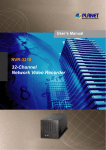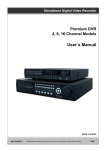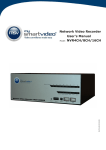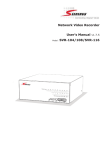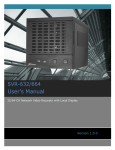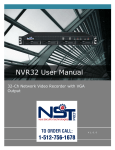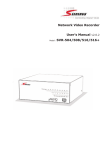Download 32-Channel Network Video Recorder
Transcript
User’s Manual NVR-3250 32-Channel Network Video Recorder Copyright Copyright © 2012 by PLANET Technology Corp. All rights reserved. No part of this publication may be reproduced, transmitted, transcribed, stored in a retrieval system, or translated into any language or computer language, in any form or by any means, electronic, mechanical, magnetic, optical, chemical, manual or otherwise, without the prior written permission of PLANET. PLANET makes no representations or warranties, either expressed or implied, with respect to the contents hereof and specifically disclaims any warranties, merchantability or fitness for any particular purpose. Any software described in this manual is sold or licensed "as is". Should the programs prove defective following their purchase, the buyer (and not PLANET, its distributor, or its dealer) assumes the entire cost of all necessary servicing, repair, and any incidental or consequential damages resulting from any defect in the software. Further, PLANET reserves the right to revise this publication and to make changes from time to time in the contents hereof without obligation to notify any person of such revision or changes. All brand and product names mentioned in this manual are trademarks and/or registered trademarks of their respective holders. Federal Communication Commission Interference Statement This equipment has been tested and found to comply with the limits for a Class B digital device, pursuant to Part 15 of FCC Rules. These limits are designed to provide reasonable protection against harmful interference in a residential installation. This equipment generates, uses, and can radiate radio frequency energy and, if not installed and used in accordance with the instructions, may cause harmful interference to radio communications. However, there is no guarantee that interference will not occur in a particular installation. If this equipment does cause harmful interference to radio or television reception, which can be determined by turning the equipment off and on, the user is encouraged to try to correct the interference by one or more of the following measures: 1. Reorient or relocate the receiving antenna. 2. Increase the separation between the equipment and receiver. 3. Connect the equipment into an outlet on a circuit different from that to which the receiver is connected. 4. Consult the dealer or an experienced radio technician for help. FCC Caution To assure continued compliance. (example-use only shielded interface cables when connecting to computer or peripheral devices). Any changes or modifications not expressly approved by the party responsible for compliance could void the user’s authority to operate the equipment. This device complies with Part 15 of the FCC Rules. Operation is subject to the Following two conditions: ( 1 ) This device may not cause harmful interference, and ( 2 ) this Device must accept any interference received, including interference that may cause undesired operation. Federal Communication Commission (FCC) Radiation Exposure Statement This equipment complies with FCC radiation exposure set forth for an uncontrolled environment. In order to avoid the possibility of exceeding the FCC radio frequency exposure limits, human proximity to the antenna shall not be less than 20 cm (8 inches) during normal operation. Safety This equipment is designed with the utmost care for the safety of those who install and use it. However, special attention must be paid to the dangers of electric shock and static electricity when working with electrical equipment. All guidelines of this and of the computer manufacture must therefore be allowed at all times to ensure the safe use of the equipment. 2 CE Mark Warning This is a Class B product. In a domestic environment, this product may cause radio interference, in which case the user may be required to take adequate measures. WEEE Regulation To avoid the potential effects on the environment and human health as a result of the presence of hazardous substances in electrical and electronic equipment, end users of electrical and electronic equipment should understand the meaning of the crossed-out wheeled bin symbol. Do not dispose of WEEE as unsorted municipal waste and have to collect such WEEE separately. Energy Saving Note of the Device This power required device does not support Stand by mode operation. For energy saving, please remove the AC-plug to disconnect the device from the power circuit. Without remove the AC-plug or switch off the device, the devices will still consuming power from the power circuit. In the view of Saving the Energy and reduce the unnecessary power consuming, it is strongly suggested to switch off or remove the DC-plug for the device if this device is not intended to be active. Revision User’s Manual for PLANET 32-ch Network Video Recorder Model: NVR-3250 Rev: 1.0 (May, 2012) Part No. EM-NVR3250_v1.0 3 Table of Contents 1. PRODUCT DESCRIPTION..................................................................................................................... 5 1.1 PRODUCT FEATURES .......................................................................................................................... 5 1.2 SYSTEM REQUIREMENTS ..................................................................................................................... 6 1.3 PACKET CONTENT .............................................................................................................................. 6 1.4 SPECIFICATION ................................................................................................................................... 7 1.5 PHYSICAL SPECIFICATIONS ................................................................................................................. 8 2. HARDWARE INSTALLATION ............................................................................................................... 9 2.1 RACK MOUNTING .............................................................................................................................. 14 3. CONNECT TO THE NVR ..................................................................................................................... 15 3.1 USE DEVICE SEARCH UTILITY ............................................................................................................ 15 3.2 ACCESS NVR WITH ITS DEFAULT IP ADDRESS..................................................................................... 19 4. LIVE VIEW............................................................................................................................................ 20 4.1 RETRIEVE CAMERA’S VIDEO STREAM .................................................................................................. 21 4.2 RETRIEVE CAMERA’S STATUS ............................................................................................................. 22 4.3 PERFORM SEQUENCE VIEWING .......................................................................................................... 22 4.4 PTZ CONTROL.................................................................................................................................. 22 4.5 PERFORM PTZ PRESET VIEWING ....................................................................................................... 23 4.6 LIVE VIDEO CONTROL BUTTONS ........................................................................................................ 25 4.7 CHANGE WEB UI DISPLAY LANGUAGE ............................................................................................... 28 5. PLAYBACK .......................................................................................................................................... 29 5.1 METHODS TO SEARCH PLAYBACK VIDEOS ......................................................................................... 30 5.2 EXPORT PLAYBACK VIDEOS TO AVI FILES.......................................................................................... 34 6. SYSTEM SETUP .................................................................................................................................. 36 6.1 SYSTEM CONFIGURATIONS ................................................................................................................ 36 6.1.1 Network Settings................................................................................................................... 36 6.1.2 DDNS Server .......................................................................................................................... 38 6.1.3 Time and Date........................................................................................................................ 41 6.1.4 User Account ......................................................................................................................... 42 6.1.5 Group Privilege ..................................................................................................................... 43 6.1.6 Disk Setup.............................................................................................................................. 44 6.2 CHANNEL CONFIGURATIONS .............................................................................................................. 49 6.2.1 Add a Camera ........................................................................................................................ 49 6.2.2 OSD Settings ......................................................................................................................... 54 6.2.3 PTZ Preset Settings .............................................................................................................. 55 6.2.4 PTZ Preset Sequence ........................................................................................................... 56 6.2.5 E-Map Setting ........................................................................................................................ 57 6.3 EVENT CONFIGURATIONS .................................................................................................................. 61 6.3.1 General Settings.................................................................................................................... 61 6.3.2 I/O Settings ............................................................................................................................ 61 6.3.3 Event Servers ........................................................................................................................ 62 6.3.4 Event Triggers ....................................................................................................................... 64 6.4 RECORDING CONFIGURATIONS .......................................................................................................... 67 6.4.1 General Settings.................................................................................................................... 67 6.4.2 Schedule Recording ............................................................................................................. 69 6.5 SYSTEM OPTIONS ............................................................................................................................. 70 6.5.1 Device Information................................................................................................................ 70 6.5.2 Logs and Reports.................................................................................................................. 70 6.5.3 Maintenance........................................................................................................................... 71 6.5.4 Disk Status............................................................................................................................. 74 6.5.5 USB Backup.............................................................................................................................. 74 4 1. Product Description The PLANET NVR-3250 is the rack-mount NVR, which optimizes your space utilization by controlling your systems in just 1U space on the rack. It is the new model of Network Video Recorder (NVR) series designed for IP surveillance system. Users can just turn on cameras and the NVR to easily protect their office and property under the Ethernet / IP networks. The recorded video files can be saved in the NVR and no need of using additional PC for files storage, which brings users a secure surveillance system with lower total cost. The NVR-3250 provides powerful central surveillance management capability with its bundled Central Management Software (CMS). One NVR-3250 can manage up to 32 IP cameras via a connected IP network. With the bundled CMS, the NVR system is expandable for multi-sites management of up to 1024 surveillance channels simultaneously*. With the NVR-3250, users can view remote surveillance in real time and play back recorded videos via the bundled CMS software or the web browser. The NVR also helps the administrators to monitor the surveillance system more efficiently by providing multi-monitor and E-Map function. The NVR-3250 not only supports PLANET IP cameras but also is compatible with most of major IP camera brands in the market. Furthermore, the NVR-3250 can automatically search and find the available cameras in the network and provide smart setup wizard program, so it greatly reduces users’ effort when setting up the system. The NVR-3250 is suitable to fit in various network environments. Besides for small scale applications in retail stores and SMB, the NVR-3250 offers 4 SATA HDD supporting RAID 0 / 1 / 5 / 10 function and able to be applied in large scale surveillance such as bank, enterprises, transportation, campus and etc. * The full version of CMS software can be purchased additionally to manage up to 1,024 channels by working with the NVR-3250. 1.1 Product Features Video/Audio: Simultaneous Recording and Live Video Streams 32 channels IP cameras input Supports M-JPEG / MPEG-4 / H.264 multiple compressions Video resolution up to 5MP (2560 * 1920) VGA local display Two-Way Audio function (G.711, G.726) Record: Manual / Schedule / Event recording of 32 IP cameras simultaneously Video recycle function makes the video recording in 24/7 960fps at 1.3MegaPixel, H.264 Supports 4 SATA HDD (RAID 0 / 1 / 5 / 10), up to 3TB per HDD 1 x E-SATA (Max 8TB) Exports record video file to AVI format System: Web / Local and management utility for easy configuration E-Map interface in Web / Local and utility configuration Auto discover by management software Smart IP camera search DI / DO port for external sensor and alarm 5 Multiple languages support Supports mobile phone remote view with Android, WinMo, Symbian S60, iPhone, Blackberry 4.6 Manage up to 32 NVRs (max. 1024 IP camera channels) with the management software Supports Real Time Clock (RTC) Network: 1 x RJ-45, 10/100/1000Base-T TCP/IP, DHCP, DNS, HTTP, FTP, NTP, SMTP, UpnP Microsoft Networks (CIFS/SMB), Internet (HTTP), FTP Hardware: 1U standard 19” rack-mount designed. Gigabit Ethernet port E-SATA / VGA / USB interfaces supported Audio line-in, line out, Mic port Supports external UPS Auto power-on and recording after power recovery 1.2 System Requirements The following are minimum system requirements for the system to operate Network Video Recorder (NVR): Operating System Microsoft® Windows® 2000 Professional, Windows® XP Professional (32 bit) or Windows® Server 2003 (32 bit) Browser Microsoft Internet Explorer 7 or above CPU Minimum Intel® Pentium® 4 2.4 GHz or higher (Dual Core is recommended) RAM Minimum 1 GB of RAM, 2GB or above is recommended Network Minimum 10/100 Ethernet (Gigabit Ethernet is recommended) Graphics Adapter AGP or PCI-Express, minimum 1024 x 768, 16 bit colors.(We highly recommend to work above the 1024 x 768 resolution to get the full experience of the software) " NOTE Make sure your display DPI setting is set to default at 96DPI To set DPI value, right-click on desktop, choose “Settings” tab >> “Advanced” >> “General” English 1.3 Packet Content 1 x NVR 1 x Power Cord 1 x RJ-45 Cable 1 x CD-ROM 1 x Quick Installation Guide 16 x HDD Screw 2 x Angle Bar 4 x Angle Screw 2 x Handle Kit 4 x Angle Screw 6 1.4 Specification Product NVR-3250 Video/ Audio Video Input 32 channels IP cameras Video output VGA local display, web interface Resolution 5MP/Full HD/MegaPixel/FD1/CIF/QCIF Local video display Vdeo streamming: H.264/MPEG4 VGA output Snapshot: MJPEG Audio Yes (G.711/G.726) Two-way at local/web interface Record Recording Mode Frame Rate/ Resolution Export File Format Storage Device Manual, Schedule, Event 960fps at 1.3MegaPixel, H.264 AVI 4 x 3.5” SATA hard disk connectors Max. Capacity: 12TB (3TB per HDD) 1 x E-SATA (Max 8TB) System Management User Interface E-Map Web-Based administration USB mouse/Keyboard at Local control Network Time Protocol Multiple users account E-mail notification System log Firmware upgrade Web browser CMS utility Local display interface Web browser CMS utility Local display interface USB Interface 4 x USB port, Firmware upgrade, USB mouse/keyboard DI / DO 8/4 Network Ethernet Network Service 1 x RJ-45, 10/100/1000Base-T TCP/IP, DHCP, DNS, HTTP, FTP, NTP, SMTP, UPnP Network File Protocol Microsoft Networks (CIFS/SMB), Internet (HTTP), FTP Hardware 7 Button LED Display Power Operating Temperature Dimensions (W x D x H) Weight z Power, Reset 1 x Power 1 x System 1 x Event 100~240V AC, 0.7A / Max. 50/60Hz 0~40 Degree C 462 x 430 x 54 mm 7Kg The full version of CMS software can be purchased additionally to manage up to 1,024 channels by working with the NVR-3250. 1.5 Physical Specifications Front Panel LEDs Color Description Power Blue During power on / restart / reset to default / OS fail:stays solid System Amber Firmware upgrade : blinking System failure (AP fail) : off System Normal : Solid Event Amber Event Recording : Solid No event : Off 8 Rear panel Connector VGA Ethernet USB E-SATA Audio I/O Description VGA output 10/100/1000 Mbps network. Connect your USB flash disk for firmware upgrade and backup. External E-SATA HDD Line in/Line out/Mic DI x 8 / DO x 4 2. Hardware Installation English 1. Start by removing the front plate. 9 2. To remove the front plate, turn the tool-less screws on both sides counter-clock wise to loose it from the unit. Please note the screws will still be attached to the front plate even after the screws are completely loosened from the unit. 3. Simply pull to remove the front plate once the screws are loosened from the unit. 10 4. Remove the HDD tray by pulling the latch. 5. Push the tray door back to the case to secure it. 11 6. Once the tray is removed from the unit, notice there are four holes, which are used to secure the HDD. 7. Once the HDD is placed in the tray, flip it over and secure the HDD with the screws. 12 8. Push the tray back in to the unit and push it all the way in. 9. Secure the tray by pushing in the latch, which locks the tray with the unit. 13 2.1 Rack Mounting To install the NVR-3250 in a 19-inch standard rack, please follows the instructions described below. Step1: Place the NVR-3250 on a hard flat surface, with the front panel positioned towards the front side. Step2: Attach the rack-mount bracket to each side of the NVR-3250 with supplied screws attached to the package. You must use the screws supplied with the mounting brackets. Damage caused to the parts by using incorrect screws would invalidate the warranty. Step3: Secure the brackets tightly. Step4: Follow the same steps to attach the second bracket to the opposite side. English Step5: After the brackets are attached to the NVR-3250, use suitable screws to securely attach the brackets to the rack, 14 3. Connect to the NVR There are various ways you can connect to the NVR and below are the suggested methods for different network setup: The NVR is placed in a network with a DHCP server: Connect to the NVR by using “Device Search” Utility. The NVR is placed in a network without DHCP server (or you are connecting to it directly): Access NVR with its default IP (192.168.0.20). 3.1 Use Device Search Utility If the NVR is placed in a corporate network or a local area network where a DHCP server is already presented, please install the “Device Search” utility from the bundled CD disk. To begin, launch the Device Search” utility from the CD and proceed with the installation. 15 Please click “Next” to continue. Please click “Install” to start the installation. Once the installation is complete, please check the “Finish”. 16 Please go to Start => Programs => NVR => Search NVR to run the search tool. Then you will see the utility start search the network. The NVR should be located and its IP address should be displayed: Double-click on it and the program should automatically access the NVR’s web administration page from your default browser. You may change NVR’s IP address by click on the button highlighted below. You will be prompted for the NVR’s login information before proceeding to change device’s IP address. You may click on the button highlighted below to perform search again. Or double-click on any of the search results to access NVR’s web administration page. 17 Perform search again Access NVR’s web administration page You should be prompted for the NVR’s username and password. Enter its default username “admin” and password “admin” and then click ”OK” to enter the system. Default User Name: admin Default Password: admin 18 3.2 Access NVR with its default IP address The NVR comes with a pre-configured static IP address “192.168.0.20”. However, it is only used when there is no DHCP server presented in the network. Connect the NVR and PC to your switch or hub, or connect the PC directly to the NVR using a crossover CAT5 Ethernet cable. The PC that is connected directly to the NVR (or within the same local area network) should receive an IP from it. Simply access the NVR from your web browser with NVR default IP address. You should be prompted for the user name and password. Enter its default username “admin” and password “admin” and then click” OK” to enter the system. 19 4. Live View The 32 channel NVR comes with a 32-video split window view with one video displays on a larger window. Select a channel from the drop-down menu to display its video on the larger split window. You can also double-click on any of the smaller one to display its video to the larger window. The “Live View” page provides the following functions: . . . . . . . . . . . Retrieve camera’s video stream Retrieve camera’s status Perform Live Sequence Viewing PTZ Control Perform PTZ Preset Sequence viewing Perform manual recording Take snapshot Receive audio of a video stream Send audio Control “Buzzer” Change web UI display language 20 4.1 Retrieve camera’s video stream The camera list is expanded and displayed on the Live View page. .Click “All” to display videos in the 32-video mode (NVR-3250) .Click on a “Group” (ex. Group 1) to display videos from cameras under that group in quad view. .Click on any camera to display video in single-view mode 21 4.2 Retrieve camera’s status The camera list can show each camera’s current status. Each status is represented with different colors and their meanings are explained on the left. Camera is connected Camera is NOT connected Camera is current performing recording 4.3 Perform Sequence Viewing Sequence view is a function that allows you to view multiple video streams from certain cameras in sequence automatically with having to select them one by one. To perform sequence view, select “Sequence” from the upper-left hand corner. Then select one or more camera(s) or camera group(s) for sequence viewing Then select dwell interval from the drop-down menu Finally click “Start” to start sequence viewing Click “All Channels” to quickly select all available channels and start sequence view in single-view mode. Click “All Groups” to quick select all available groups and start sequence view in quad-view mode. Or simply select the desired channels and press “Start” to start sequence view. 4.4 PTZ Control PTZ control provides functions to pan, tilt, and zoom a PTZ camera as well as the ability to adjust camera focus and iris. 22 Camera(s) that are currently being selected for live viewing will be listed in the PTZ drop-down menu. Simply select a camera then use the PTZ control panel to control the camera. The bar shown below allows you to control the pan/tilt speed. 4.5 Perform PTZ Preset Viewing There are three functions provided in the “Preset” section: . . . Perform preset point viewing of a particular camera. Auto pan a particular camera. Perform preset point sequence viewing. Preset Point Viewing Start by selecting a PTZ camera from the drop-down list: It’s available PTZ preset points will be listed in the drop-down list shown below: Select a preset position from the drop-down list and click “Go to” to move the live view to that position. 23 Auto Pan Viewing Start by selecting a PTZ camera from the drop-down list: Use the Auto-Pan control buttons to pan right, left and stop auto pan. Auto-Pan * Certain cameras do not support bidirectional pan movements. Use the “AutoPan” button for such cameras. Pan Left Stop pan Pan right Preset Point Sequence Viewing This function allows you to view multiple preset points’ videos of a camera without having to select them one by one. Once you have defined the prefer preset points in “Camera Configuration” => “PTZ Preset Sequence” under the “Setup” menu, click “Start” here and the recorder will begin to display videos from those preset points in sequence automatically until you click “Stop”. 24 4.6 Live Video Control Buttons Each live video window comes with control buttons with functions described below: Take a snapshot of a live video. Turn on/off audio of a live video. Start/stop recording of a live video (manual recording) Audio post function. ( Available if the camera support this function) Full screen view of a live video Display video in its original ratio 25 Take a snapshot of a live video To take a snapshot of a live video, click the displayed in a pop up window shown like below. button and the snapshot of the video will be Right-click anywhere on the image and select “Save Image as” from the pull-down menu. In the pop up dialog, name the image file and choose which directory the image will be saved to and click “Save”. Full Screen View of a Live Video To view a video in full screen, click the button. To exit full screen video, double-click anywhere on the video. Turn On/Off Audio of a Live Video You can retrieve audio from a particular camera. Simply click the 26 button to do so. The button will show in different color once the audio is turned on. Click on it again to turn off audio. You may only turn on audio once channel at a time Start/Stop Recording of a Live Video You can manually start or stop recording of a live video by using the The button will show in different color once the recording is started manually. stop recording. button. Click on it again to Audio post This function allows user to speak from a PC through a microphone and the audio can be played at the camera side if it has a speaker connected to it. 27 4.7 Change Web UI Display Language You can change the web UI display language from the current login username link located at the upper-right hand corner. Click on the link opens up a new window which displays detail information about the user as well as a drop-down menu which lets you change the display language. 28 5. Playback Playback is a function that allows you to play one or more videos that were previously recorded by a chosen recording method or due to an event trigger. The NVR offers synchronized playback from up to 4 channels and various types of search methods are provided to help you find the footage you need quickly. You can turn on or off the audio of a recorded video at your choice if audio was also recorded during the recording of the video. Playback video can be viewed in full screen and snapshots can be taken and saved during a video playback. 29 5.1 Methods to Search Playback Videos The NVR offers three methods to quickly help users find videos that were previously recorded: Search by time Specify a time range and search videos recorded within that range. Search by event Find videos that were recorded due to event triggers Most Recent Events Play by start time Displays the most recent 15 events Enter a specific time a video was recorded to start playing back the video Search by time chart Start by selecting which channel(s) you would like to perform a search on: Selected channels will be marked in red Select “Search by time chart” from the “Search Method” drop-down list and click “Go” to start the search: 30 Results will then be displayed in a new dialog with a “Month/Channel” table and boxes marked in dark gray represent videos found in those dates. (* Videos from other cameras that are recorded on the same date will also be displayed) Clicking on a cell box marked with gray will take you to the "day" view of the selected month. Repeating the same step will eventually take you to the "second" view (5sec per cell box). Right-click anywhere or the "Back" button on the table will take you back to the previous view. Click on the play button at anytime will start playing videos from the beginning of the current time view (ex. if the table is in the "month" view, click play will start playing from the first available clip of that month) Click on the cell box again will start playing back the videos if you have reached the end of search results: Videos found from other cameras that were recorded at the same time will also be played. 31 Search by event Start by selecting which channel(s) you would like to perform a search on. Select “Search by event” from the “Search Method” drop-down list and click “Go” to start the search. Results will then be listed like what is shown below (displays the oldest record top down). Click on a particular result to start the playback. * You can click “Next Search” to display the next 15 results. . You may also specify a new start time to search and display results from then on. You can restrict the number of results to be displayed at once (max. 30) and perform the search again. 32 Play by specific time If you know when a recording was taken place, you may choose the” Play by start time” from the “Search Method” drop-down list. Then you will be prompted to enter a specific time and date for the recorded video. Use the button to select month, date, and year. Search by event (Most Recent) This function quickly displays the most recent event recordings from the selected channels, displaying the most recent result top down. You may click “Update” to update the list to display the most recent result. 33 5.2 Export Playback Videos to AVI Files User can export the recorded playback videos stored on NVR-3250 to a local computer and save them in AVI file format. The files can then be played on the PC by a 3rd party media player such as VLC player or Windows Media player. Once you locate the recorded videos with steps described in the previous section, hit the “Export AVI” button on a video window of the video you wish to export. A new dialog will pop up and allows you to specify the time frame (or length) of the video you wish to export. Click the button to pull down the calendar to help you specify the month, date and the year Specify the starting and ending hours of the video by entering numbers in the text boxes. 34 Hit the “Start” button to start exporting. The file will be automatically named and saved under the C:\ partition. You will be notified once the process is completed successfully The exported AVI file will be saved under the C partition. * Ffdshow is required in order to play the exported AVI file with Windows Media Player. You can get it at “http://sourceforge.net/projects/ffd-show-tryout!” to download the “ffdshow_beta6_rev2527_20081219.exe”. 35 6. System Setup 6.1 System Configurations The “System Configurations” page provides users options to setup the device quickly and properly. After properly configuring all settings in all the sub-pages, users should expect a fully working network video recorder that is ready to manage cameras on the network. We will start by configuring its network settings to make sure it works correctly in your network. Next, we will help you adjust the system time so videos will be recorder with correct timestamp. To better secure the system for unwanted disturbance, we will guide you on setting up user’s account and privileges to prevent settings gets altered by users other than the system administrator. Lastly, we will tell you what you should expect after installing a hard disk and how to prepare the hard disk for the video recording. 6.1.1 Network Settings You need to adjust settings in this page for the device to work properly in your network. It is critical that settings here are configured correctly based on your network configurations so that the recorder can be administered through the local area network and cameras can be connected from it. By default, the recorder is set to obtain IP address from DHCP server, it should be sufficient in most network environments, and most likely you should not need to alter anything in this page. To locate the recorder, simply use the IP Utility with steps described in page 13. If you wish to set the recorder to use a static IP address in your local area network, 1. Choose “Static IP” from the “Connection Type” drop-down menu 2. Enter the IP address, subnet mask, default gateway address and DNS server address for the recorder 3. Enable “DHCP Server” under “DHCP Server” if you wish to use the recorder as a DHCP server, or leave it disabled if there is already a DHCP server in the network 36 . 4. Click Apply for the settings to take effect. The recorder can detect the presence of a DHCP server upon startup. It sets itself to use static IP address if there is no DHCP server currently presented in the network. Its DHCP server function is also turned on at the same time to assign IP addresses to cameras that are later connected to the network. You can manually turn off the DHCP server function if you wish to use a separate DHCP server. Change the recorder’s IP address would require the recorder to restart. Restart the device under “system Options” >> “Maintenance” for the settings to take effect. 37 6.1.2 DDNS Server DNS, which stands for “Dynamic DNS”, is a method, protocol, or network service that provides the capability for a networked device, such as a router or computer system (in this case, the NVR) using the Internet Protocol Suite, to notify a domain name server to change, in real time, the active DNS configuration of its configured hostnames, addresses or other information stored in DNS. A popular application of dynamic DNS is to provide a residential user’s Internet gateway that has a variable, often changing, IP address with a well known hostname resolvable through standard DNS queries. This is useful if the NVR is placed on the Internet with a dynamic public IP, which once the DDNS is properly setup, users can access the NVR remotely with the DDNS domain name without worrying if the IP has changed or not. *Please make sure a valid DNS server has been configured under the “Network Setting” page in order for this function to work properly. *The NVR currently only works with free DDNS service provided by “DynDNS”. For more information, please go to www.dyndns.com *If the NVR is placed behind a router or Internet gateway, please make sure port forwarding for port 80 is configured on the router or the gateway in order for the DDNS function to properly register with the service. It’s often suggested to use the DDNS function in the router / gateway for such case instead. *Once you have the DDNS function successfully up and running, please DO NOT forget to configure port forwarding for the NVR web port (default 80) and the streaming port (default 9877) in the router/gateway for remote viewing. You can then type in http://yourddnsdomain in the browser to access the NVR remotely for live view. 38 1. In order to properly configure the DDNS service function, please register a free DDNS domain name and account from DynDNS first. Go to http://dyn.com/dns/dyndns-free/ from the browser to do so. 2. Fill in the necessary fields as illustrated above 3. The page will check whether the hostname you entered has been used by another user or not as soon as you click the “Add to Cart” button. If you see below message, simply enter a different and click “Add to Cart” again 39 4. Once you get to the next page, fill in the necessary fields as illustrated above 5. Go back to the NVR’s DDNS service configuration page under “Setup” >> “System Configuration” >> “DDNS Service”.Fill in the domain name you picked during the registration in the “Domain Name” field and the username/password you created in the “User ID” and “Password” field and click “Apply” to finish 6. You can click the “Check DDNS Status” button to check the DynDNS service status. If you are getting a “Disconnected” message, it means that DDNS service server is down or the NVR is not connected to the Internet. If everything is ok normally, you should be prompted with a success message 40 6.1.3 Time and Date Set the time and date by selecting the time zone according to your location. It is imperative that you set the recorder’s time correctly to avoid the following errors: • Incorrect display time for playback videos. • Inconsistent display time of event logs and when they actually occur. After selecting the time zone, choose an option below to set the recorder time. Manual Sync with NTP server Sync with PC Use the drop-down list and configure the time manually enter the hostname or IP address of a valid NTP server And set how often the recorder should synchronize the time with the recorder by using the “Update interval” drop-down menu. Check this option to synchronize the recorder time with the PC That you are currently using to access the recorder. 41 6.1.4 User Account The recorder can be accessed by multiple users simultaneously. You can add, remove, and edit users by using options provided in this page to keep user information organized. Each recorder comes with a built-in “admin” account with password “admin”. It’s highly recommended to change the password upon your initial login. To change the password of the “admin” account: 1. Click and highlight the “admin” account in the account list and click “Edit”. 2. Its information should be displayed in “User Account Information”. 3. Enter a new password in the “Password” field and enter it again in “Confirm Password”. To add a new user: 1. Enter a username and password in “User Account Information”. All other fields are optional for Your own reference. 2. Select a group from the “Group” drop-down menu to assign the new user to a particular group. Enter a short description for the account if you wish. 3. Click “Apply” to finish configuration. 42 6.1.5 Group Privilege Group Privilege is where you can create multiple customized access policies for situations if you need the recorder to be accessed by users other than the administrator. You can do so by creating a group, and then remove access privileges for certain configuration pages or cameras. Users that are created and assigned to this group will have limited access instead of full administration rights. The recorder comes with seven built-in groups and five built-in privilege profiles, except the “admin” and the “guest” accounts; the other five groups are fully customizable or you can simply assign a group with one of the default privilege profiles. You can, however, assign more than one users to the “admin” account if you wish to do so. The guest account comes with a “view-only” privilege in the “Live View” page, and users in this group do not have the power to make any changes in the “Live View” page or have access to pages other than the “Live View” page. 43 To create a group, select a group from the “Group” drop-down. Menu You can change the group name by clicking the “Change Group Name” button. A text box will be displayed for you to enter the new group. Choose what type of privilege you would like this group to have from the “Privilege Type” drop-down menu. Its access privilege will then be displayed. You can alter its settings by allowing or denying access to other cameras using the checkboxes instead of accepting the defaults. 6.1.6 Disk Setup Once you install a hard disk to the recorder, you would need to initialize it so that it can be ready for recording. You can obtain basic information about the disk you installed in this page. To initialize it, simply click the “Format” button. You can also connect external USB thumb drive to the recorder for firmware upgrade. 44 This page will list the Internal disks (or RAID volumes), and the E-SATA disk only. The HDD will be formatted in EXT3 file system. The USB HDDs will only be listed in the "USB Backup" and "Hard Disk Status pages in "System Options". The USB HDDs have to be formatted in advance in FAT16/FAT32 or EXT3 file system. (FAT32 is recommended). Build RAID Volume The internal HDDs can be used for RAID. To do so, go to "RAID Volume" in Disk Setup and choose the available disk action The "Disk Actions" drop-down menu displays available actions based on how many HDDs are installed in the NVR. For detail, please refer to the table above. 1. Select a disk action and click "Apply" to proceed. A warning dialog will be displayed as creating RAID volume will erase all existing data on the HDDs. Click "OK" to continue. 45 2. Please wait for a few moments while the NVR is creating the RAID volume. 3. You will be prompted once the action is completed successfully. 4. Once the RAID volume is created, it will be listed in the "RAID volume list with the status of "Offline" 46 5. Go back to the "Hard Disk List" page and the RAID volume should be in the list. Click "Format" to bring the RAID volume online. 6. The status will be displayed just as if you were formatting any internal HDDs 7. Once a RAID volume is created, it can be deleted at anytime by choosing the "Delete RAID" action in the RAID volume page. All existing data will be removed after the RAID volume is deleted. All internal disks that were originally used for RAID volume will have to be formatted again after the RAID volume is deleted. 47 Once a RAID volume is created, the “Delete RAID" option should be presented in the “Disk Action” drop-down menu. (Regardless the RAID volume has been formatted or not) Only RAID1 and RAID 5 have repair function The recording should continue even when RAID 1 or RAID 5 volume fails or is rebuilding. The replacement hard drive size must be larger or equal to the size of the smallest disk in the volume. The internal disks do not need to be formatted prior to creating RAID volume Create RAID with an existing RAID volume is not allowed Once a RAID volume is deleted, all internal disks within that RAID should become offline and need to be formatted again before they can be used individually. All internal disks (or RAID volumes) need to be formatted before they can be used. 48 6.2 Channel Configurations 6.2.1 Add a Camera The NVR provides two options for adding a new camera. Users have the option to let the recorder automatically find the cameras or it is possible to enter camera’s information and add it manually. Automatic Search: 1. Click the “Search” button to perform the camera search. You should be prompted to install Active Control component in order for the search to function properly. Go ahead and click “Install” 2. After that, the search should begin and its status should be displayed. 3. Found cameras should be listed and simply select a camera from the list and press “Configure”. 49 50 4. It is corresponding information should be displayed in the “Camera Information” section. Enter its username and password and select the channel ID and name the camera. 5. Click on “Detect” to establish connection between the recorder and the camera. If connection establishes successfully, camera’s detailed information should be polled and displayed as below. 6. Adjust its video format, frame rate, resolution or bitrates…etc if you wish. You can also click on the “Preview” to preview the live video of the camera. Click “Add” to finish adding the camera. If cameras are marked with “*” in the search result, it means those cameras are already configured and connected to NVR. Add a camera manually Simply follow the instruction described above but instead of using the “Search” function, enter the camera’s IP address and credential in the “Camera Information” manually, then follow step 5 and 6 described above. 51 Enter manually Once the camera's settings are polled and displayed, you can also enable "continuous" recording and adjust its recording quality settings before adding the camera. Some cameras are capable of multiple streaming profiles, in which different video codes are used for different purposes. You will be able to use different video format for continuous recording if it's a multi-stream capable camera. There are two types of fps settings here, one is the fps that NVR sets back to the camera, and this is the fps NVR will be receiving from the camera. The other is recording fps which will be limited by the live fps. (Ex. if the live fps is set to 10, choosing "Full" in the recording fps meaning it will only record at 10fps maximum. For MPEG/H.264, only I frame or full (i+p frame) can be selected for recording fps. 52 For single stream camera, only the recording fps can be adjusted. Simply follow the instruction described above but instead of using the “Search” function, enter the camera’s IP address and credential in the “Camera Information” manually. 53 6.2.2 OSD Settings The OSD (On Screen Display) allows users to add informational text message and embed it onto the video. By default, this function is turned off. To add texts to one or more videos. 1. Select a camera you would like to add text to and choose “Display OSD”. 2. Choose one or more display options if you would also like the recorder to automatically embed the system time or the frame rate for you. Or simply choose to display a custom message of your own. 3. Next, define where the text will be displayed by either entering an X/Y coordinate or use the system pre-defined position from the drop-down menu. 4. Click on the “Preview” button to see the preview of your setting and click “Apply” to save the configuration. . The texts can be further adjusted with changes to different size, color or font so they can be more visible on the video. 54 6.2.3 PTZ Preset Settings The recorder supports PTZ cameras and can set multiple preset points or retrieve and manage preset points that are set in the camera. This is helpful if you need to monitor multiple spots in one area from a particular camera. 1. To set up PTZ preset points, select a camera from the “Camera” drop-down menu and click “Add”. 2. Select a position number for the preset point from the “Position Number” drop-down menu and fill in a name in the “Position Name” field for easier identification. 3. Use the PTZ control provided in the configuration page to set the preset point and set the position as the “HOME” position if you wish. 4. Click “Apply” to save the configuration. 55 6.2.4 PTZ Preset Sequence Once you have multiple preset points defined for a camera, it is convenient for monitoring to set up the sequencing viewing among those preset point and let the recorder automatically switch between them for you. To configure preset sequence for a camera, 1.” select a camera from the “Camera” drop-down menu. The available preset points should be listed in “Camera Presets” section. 2. Pick the ones you like for sequence viewing and press the “->” button to move them to the “Adjust Position” section, then use the up and down buttons to adjust their sequences. 3. Finally, select a dwell time from the drop-down menu and click “Apply” to save the configuration. 56 6.2.5 E-Map Setting 6.2.5.1 Local Map Setting Local Map Setting is a function that alerts users whenever there is an event triggered (e.g. motion detected) from a camera with a geographical perspective. With this function, users can quickly identify which camera has detected an unusual event and where this event is happening. This function works by incorporating the event detection function as well as the recording function, which, as a result, helps users take all the necessary actions when an unusual event occurs. To replace the map, click “Browse” button to locate the new map image file from the local PC and then click “Upload”. 57 Then click and drag the camera icon to move the camera to define its location. Access the E-Map Monitor page from the upper-right hand corner menu. When the NVR receives an event triggered from any of the cameras, their videos will be displayed on the E-Map and you can double-click on the video to enlarge it. 58 6.2.5.2 Google Map Setting The Google Map monitor is a similar function to the aforementioned E-Map monitor. It is useful if you are managing multiple cameras from different locations. To configure locations of each camera, first determine the location You’d like to place the camera to on the map. You can do so by: 1. Zoom in to a smaller area by using the zoom control bar on the map 2. Zoom in to a smaller area by using the mouse scroll button You can also go to a specific place on the map by entering its address or the name of the place in the “Address or places of interest” field: Once the location has been determined, click and drag the camera icon to move it to the desired 59 location: * Click and drag the icon to re-arrange its location The Google Map Monitor requires active Internet connection and can not be used in conjunction with the regular E-Map monitor function. • You can click anywhere on the map and hold down the mouse left button then drag to move the map itself You can then access the Google Map Monitor from the top menu: 60 6.3 Event Configurations The “Event Configurations” section allows users to define conditions that constitute an event, its corresponding trigger action and when it will be triggered. Such setting can reduce the management overhead and notify the administrator only when it’s necessary. 6.3.1 General Settings The general settings section can help you quickly configure when an event is triggered, how often events are triggered and the corresponding actions when events are triggered. Start the event configuration by defining the general settings: Define when an event will be triggered. • Choose “Always” or “Only during…” under “Event Trigger Duration”. • For the “Only during…” option, choose the days by using the check-box and then define the time range in those days in the “Start Time” and “End Time” fields that you would like the event trigger function to be enabled. How often an event is triggered • Set a time interval under “Event Trigger Interval” to define how often events are triggered. Trigger action Now that you have the event trigger duration and interval defined, choose what action to be taken during an event trigger: • You can choose to have the recorder send out the first few frames of the video recorder upon an event is triggered. • You can also choose to have the recorder send out a warning message in e-mail or in txt file format and upload it to a destined FTP server. 6.3.2 I/O Settings This function allows users to manage camera’s digital input and output ports right from the recorder. You can setup the recorder to receive triggers from a particular camera’s input port and trigger a device, such as an alarm that is connected to the recorder or camera’s output port. Cameras that do not have built-in digital input/output port can also be configured to pair with the recorder’s DI/DO ports. 61 1. For cameras that come with physical digital input ports, their ports will be listed in the far left drop-down menu. 2. Pick the desired channel for I/O mapping, and then select the camera’s input port from the drop-down menu. 3. Select the trigger condition from the “Condition” drop-down menu. 4. Select the recorder’s input port if you would also like to use the recorder’s input port for event trigger. And then select the trigger condition as well. 5. Next, select the recorder’s output port and the trigger action. 6. Finally, define the trigger duration. " NOTE 1. The recorder does not control camera’s input or output ports in a way to let you pair recorder itself with a camera’s input or output port for event receiving or triggering. 2. The recorder only acts as a medium for pairing up input/output ports between cameras and the recorder. 3. Only connected cameras will be displayed in the list. 4. Some cameras only allow one trigger source be configured at a time, e.g.: if the camera has the motion detection function turned on, its digital input will be disabled and vice versa. Under such circumstance, if you set to use camera’s digital input port as the event trigger source, you will not be able to select motion detection as the /trigger source for this camera under “Event Configurations” >> “Event Trigger” setup page. 6.3.3 Event Servers Event servers are to be used with event trigger actions. In case of unusual motion detected by the camera or a disk failure, the recorder can send notification with the acceptable format (image/txt) to a destined event server according to the configuration. Configuring an FTP server 62 To add an FTP server, 1. Start by giving a name to the server that you are adding to the recorder. 2. Enter the hostname or the IP address of the FTP server. 3. Enter the communication port of the FTP server (usually port 21). 4. Enter the username and password of the FTP server if it’s required 5. Check “Use Passive Mode” if it’s required or leave it unchecked to use active mode. 6. Click “Test” to verify if all information is entered correctly and the connection to the FTP server can be established successfully. 7. Click “Apply” for the settings to take effect. 63 If you wish to edit/remove/enable/disable an FTP server, click to highlight one from the profile list and choose the corresponding action button. Configuring an SMTP server 1. Enter the hostname or the IP address of the SMTP server. 2. Enter the port of the SMTP server. 3. Specify the sender’s name in the “Sender’s name” field. 4. Enter the sender’s e-mail address. 5. Check “Enable Authentication” and enter the username and password of the SMTP server and it requires authentication. 6. Click “Apply” to save the configuration. 6.3.4 Event Triggers We have finished defining how an event will be triggered and which servers will be receiving notifications in the previous two sections, now we can finish up the event configuration by setting. .Which channels will have event trigger function enabled. .What is considered to be an event. 64 .Where the warnings will be sent to and how they will be sent. Select Channels to Enable Event Trigger and which type of event should be triggered. Use the checkbox to enable event trigger on the desired channels. Define which system events should trigger the recorder to send out notifications Define how the notifications will be sent and where they will be sent to. 65 * Event trigger may not work for cameras that are placed outside of your local network or on the Internet until the UPnP Port Forwarding” is enabled in both the NVR and the router. 66 6.4 Recording Configurations The “recording configurations” gives users the overall control of how and when a recording is performed and the quality of different types of recordings performed on each channels. It can help the recorder to operate with sufficient system resource by performing recording only when it’s necessary with adjustable recording frame rate. 6.4.1 General Settings You can define the following in “General Settings”: • Pre-Alarm/Post-Alarm recording length • Recording frame rate • Define to always keep a number of days of previously recorded Data • Enable/disable different recording types on different cameras • Enable/disable audio recording The “recording buffer” allows user to define “pre-alarm” and “post-alarm” time for event recordings. The “pre-alarm” time sets the NVR to record in advance when an event is triggered. The “post-alarm” time sets the NVR to continue recording for a period of time after an event trigger is finished. * The “Pre-alarm” function only Works when the “Continuous” Recording is also activated. Recording frame rate allows you to set different frame rate for different types of recording instead of recording at one frame rate only. Use the drop-down menu and select one of the pre-defined frame rates for a particular recording type. 67 Users can also set to keep a previous number of days of recording data by enabling the option below. This is quite often used in application such as banking which certain countries requires to always keeping a minimum previous number of days of recording data. * If this option is enabled, once the hard drive is full, the recycle function will then start but it will ensure that the number of days of recording data defined here will stay in hard drive instead of wiping out 20GB of data at a time. * If the hard drive is not full, the NVR re-calculates twice a day (each at 2:30am and 2:30pm) to keep the defined number of days of recording data from these two particular points of time backward. The section at the bottom allows you to turn on or off a particular recording type on any channels. The “Camera Recording Setting” section allows you to turn on or off a particular recording type on any channels. The section at the bottom of the page allows you to disable audio recording (record video only) of particular channels. 68 6.4.2 Schedule Recording Here you can define the time range of the schedule recording for all channels. To configure a schedule recording: 1. Use the “Camera” drop-down menu and select a camera first. 2. You can use the schedule table to set the time range. Click the cell boxes then move the curser horizontally lets you set what hours to perform recording during a day. Click and move vertically lets you set what days to perform recording at a specific time. * Each cell box represents 15 minutes of time. Click one or more boxes to omit consecutive recording. 3. You can also use the “Quick Configuration” to define recording time range instead of clicking cell box one by one on the time table. Simply check what days you would like to perform recording and specify the recording duration by either choosing “All Day” or enter a start and end time for specific recording duration. 4. Select the “Copy to” option if you would like to set the same recording schedule to another camera. 69 6.5 System Options System Options gives users a glance of the overall system status and allows users to perform maintenance tasks such as upgrading firmware, restore/backup device settings or reboot device ….etc. 6.5.1 Device Information The “Device Information” provides the general information of the device such as firmware version and system time. It also provides information of the current network settings and status. 6.5.2 Logs and Reports “Logs and Reports” keeps a record of what’s been happening to the device and provides basic information for troubleshooting. 70 6.5.3 Maintenance “Maintenance” provides functions for users to: • Reboot the NVR when necessary • Reboot cameras directly from the NVR • Perform Firmware Upgrade • Backup the NVR’s settings to a local hard drive • Restore the NVR’s settings from a previously saved configuration file • Reset the NVR’s settings to their factory default values Reboot the NVR Reboot NVR-1610 after you upload a new firmware. You would need to manually reboot the system for the new firmware to take effect. Such process would prevent a recording from getting interrupted because the system would not automatically reboot itself after the new firmware is loaded onto the recorder. Simply click “Restart” to begin the reboot process and confirm the action. The restart process should be displayed and you should be prompted back to the “Maintenance” page after it is complete. Firmware Upgrade 71 The firmware can be upgraded through web UI or USB. Before upgrading firmware, please backup configuration in advance. 72 ** the firmware file comes with a “.tar.gz” file extension, please use the file as is, DO NOT unzip it. It’s normal that you may only see “.tar” as the file extension in Windows as the OS hide the known file extension by default. Upgrade through USB thumb drive 1. Prepare a USB flash disk and format with FAT or FAT32 format 2. Place the firmware in the USB flash disk and make sure it’s placed at the top-level directory. Please do not place the file in a folder. (Make sure to change the firmware file name to “firmware” and leave its file extension “.tar.gz” as is before placing the file to the USB disk) 3. Plug USB flash disk into USB port on the NVR 4. The System LED on the NVR will start to flash in amber. This indicates firmware upgrade is in process 5. *** Warning *** Please wait until upgrade process finished, interrupt the upgrade process may cause system not work anymore 6. Wait until System LED remains solid in amber. This indicates firmware upgrade is finished 7. Power off the NVR and remove the USB disk the power the unit back on again 8. Restore configuration file back if needed Reset the NVR to Factory Default To reset the recorder back to its factory default, click “Default” button and begin the process. 73 The process should be displayed and you should be prompted back to the “Maintenance” page after it is complete. 6.5.4 Disk Status “Disk Status” gives you more detailed information of the hard drive that is currently installed in the NVR. 6.5.5 USB Backup The USB Backup provides the function to allow users to backup the recorded file of one or more channels to USB-HDD. USB HDD:Select the USB HDD you want to backup recorded file to it. Channel:Select the Channel you want to backup. Time:Start time and End time of the backup file. 74












































































